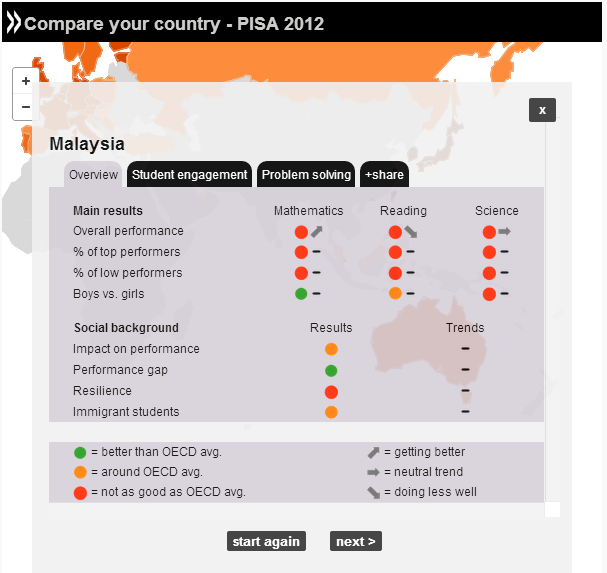The latest PISA 2012 results are out, and it comes with a twist. Instead of testing the usual ‘knowledge’ of the students, PISA crafted a new exam meant to test the creative problem solving skills of students in various countries.
Edweek.org further explains:
The assessment, which was the subject of an Organization for Economic Cooperation and Development (OECD) report released Tuesday, defined creative problem-solving as the ability to “understand and resolve problem situations where a method of solution is not immediately obvious.” Worldwide, a representative sample of 85,000 students took the exam, including 1,273 U.S. students in 162 schools.
The OECD introduced the exam based on the belief that today’s high school students will enter an economy in which on-the-job problem solving has gotten progressively more complex because computers have replaced many of the human employees whose jobs once consisted of completing simple tasks.
“In modern societies, all of life is problem solving,” states the report “PISA 2012 Results: Creative Problem-Solving: Students’ Skills in Tackling Real-life Problems,” the fifth of six OECD reports on the 2012 assessment, which also tested math, reading, and science and collected information on students’ communities, lives, and schools. “Complex problem-solving skills are particularly in demand in fast-growing, highly skilled managerial, professional, and technical occupations.”
Now we all know how badly Malaysians are doing in Science in Maths, this new test would further refine that view to see if students could actual apply the knowledge they had in real world situations–such as calculating the cheapest route from point A to point B via various train tickets. PISA feels these more accurately reflect the ability needed in the real-world, and I agree.
The bad news however, is as imminent as Haze in June. Malaysia students perform ridiculously poorly in this test, averaging a very low 422–far away from the OECD average of 500, and astronomically distant from our Neighbour Singapore where the average score was 562. Basically the ability for our students to solve problem is missing, not surprising since problem solving isn’t really something our education system is geared towards.
Looking into the finer details leads us to an even more startling discovery, under 2% of Malaysian students were top performers in all 4 domains (Problem Solving, Reading, Mathematics and Writing) compared to nearly 46% in Singapore. Meaning the top cream of the crop in Malaysia, is almost average in Singapore. It gets worse when we compare ourselves in Shanghai–because nearly 57% of students in Shanghai manage to be top performers in all domains.
The perspective is this, if you threw a stone randomly at students in Shanghai, you’re likely to hit a student who would be in the top 1% of Malaysian students–in other words you’d get an ‘elite student’ in Malaysia by just randomly selecting from a group of Chinese students in Shanghai.
Of course, PISA isn’t the full way we should benchmark our education system, but we must at least acknowledge our ridiculous failures, a lot of well to do Malaysians are voting with their feet and leaving Malaysia so that they could at least provide their children a decent education in Singapore, Australia or even the UK and US. Malaysia it seems has no future, and what makes it worse is that we seem oblivious to it.
